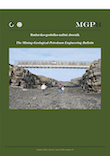Identification of high velocity anomalies, imperceptible to seismic resolution, by integration of seismic attributes, in the Penobscot Field, Canada.
DOI:
https://doi.org/10.17794/rgn.2019.1.2Keywords:
High Velocity Anomaly; Mississauga Formation; Wyandot Formation; Naskapi Member; Seismic AttributesAbstract
Penobscot Field is located in the Sable Sub-basin, in the Nova Scotia Basin, belonging to the Canadian territory, and for the year of 1991, a 3D seismic acquisition was carried out in this region. Also, two exploratory wells were previously drilled (L-30 and B-41). Then, with the subsequent interpretation of the area, a discrepancy was found around 10ms to 15ms (approximately 25m) in the travel times of the seismic waves in the vicinity of well B-41, resulting in a false structural high in the Mississauga Formation and Naskapi Member. It is possibly caused by changes in geological facies and thickness of the Wyandot formation, consequently, B-41 well became dry. For these reasons, to identify the possible problem which caused everything mentioned above, the area between the wells was delimited by a seismic subvolume (by reducing the seismic cube), making a seismic interpretation of the top of the formations of interest, as well as an analysis of certain petrophysical properties in the wells, in order to delimit the thickness of the anomaly and, consecutively, the use of the seismic attributes for lateral identification of the anomaly in the Wyandot Formation.
Downloads
Published
How to Cite
Issue
Section
License
Copyright (c) 2018 authors and journal

This work is licensed under a Creative Commons Attribution 4.0 International License.
Creative Commons-BY
Authors who publish with this journal agree to the following terms:
In agreeing this form, you certify that:
- You read the ethical codex of the RGN zbornik available at journal web.
- You submitted work is your original work, and has not previously been published and does not include any form of plagiarism.
- You own copyright in the submitted work, and are therefore permitted to assign the licence to publish to RGN zbornik.
- Your submitted work contains no violation of any existing copyright or other third party right or any material of an obscene, libellous or otherwise unlawful nature.
- You have obtained permission for and acknowledged the source of any illustrations, diagrams or other material included in the work of which you are not the copyright owner.
- You have taken due care to ensure the accuracy of the work, and that, to the best of your knowledge, there are no false statements made within it.
- All co-authors of this submitted work are aware of, and in agreement with, the terms of this licence and that the submitted manuscript has been approved by these authors.
Publication licence
You retain copyright in your submitted work, according to journal license policy (CC-BY). By signing this form you agree that RGN zbornik may publish it under the publication licence. In summary the licence allows the following:
Anyone is free:
- To copy, distribute, display, and perform the work.
- To make derivative works.
Under the following conditions:
- The original author must always be given credit.
- The work may not be used for commercial purposes.
- If the work is altered, transformed, or built upon, the resulting work may only be distributed under a licence identical to this one.
Exceptions to the licence
In addition to publishing the work printed under the above licence, RGN zbornik will also enable the work to be visible online.
The journal editorial can change the licence rules anytime but it cannot retroactively restrict author(s) rights.


